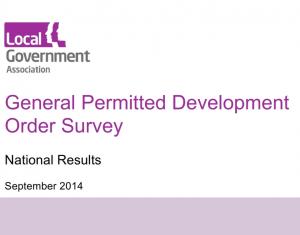
Find more posts
Office-to-residential conversions have variable impact nationwide
Latest
October 10, 2014



Research by the Local Government Association seems to indicate that the relaxation of the planning regime around conversion of offices to residential use has had a varibale impact around the country.
A significant proportion of responses highlighted the predictable negative effects such as displacement of businesses, absence of contributions to affordable housing and infrastructure. But it is a surprise that the negative responses were not higher.
22 questions were sent electronically to Heads of Planning Services and the 29% response rate itself perhaps indicates a relatively low level of concern in many areas. It would have been interesting to see the breakdown of respondents by type of authority or area but this information is not reported. 9% of authorities had received no "prior approval" notifications and another 42% between 1 and 10 - so over 50% of respondents were dealing with fewer than 10 such schemes. But 4% were responding to between 100 and 139 schemes while a further authority was dealing with 210 schemes. 4 of these authorities were London Boroughs, perhaps driven by very high London property values, and one was in the East of England.
Empty or occupied?
One of the big questions about the prior approval regime for conversions, and the one of most relevance to empty homes practitioners, is whether the buildings in question are occupied or empty. A surprising 41% said they didn't know. This indicates that the government is not asking local authorities to monitor this important aspect of the measure which will hinder an objective assessment of its impact.
Of those wtho did know, it seems that 27% said that over 50% of the applications concerned premises that had some element of occupation; and the figures indicated that the more applications were received by a particular authority, the more likely it would be for a higher percentage to be occupied. This makes sense - both figures suggest a stronger drive towards conversions.
Scale of schemes
There were signifcant differences between the scale of the conversions. Towards one end of the scale schemes in an authority that saw approval granted for 1,485 new units approved had an average of 23 units per prior approval (indicating just under 70 schemes); yet in another authority, the high number of 121 schemes approved only equated to 264 units, at just over 2 per prior approval. It would have been interesting if this data had been collected so as to allow analysis into percentiles of scheme size to see whether the averages were distorted by outliers.
Affordable Housing
In total, the report suggests that 3,107 affordable units had been lost nationwide because of the permitted development rights. In reality, the number is likely to be significantly lower as the 3,107 is presumably predicated on the policy requirement for affordable housing, whilst developers are currently driving a cart and horses through such policies on the back of the ubiquitous viability assessments. The combination of existing use values and costs of conversion works would in any case tend to create problems around achieving the full policy quota, even in a more favourable climate. In the circumstances it is not altogether surprising that only half of the respondents agreed that the permitted development regime had reduced contributions to affordable housing.
Overall impact
There was a surprisingly muted response to the overall impact. For example:
"One in four tended to agree that the PDO had reduced the availability of office space within the local area".
It is difficult to see how it could have done anything else but reduce the availability of office space: perhas the question was interpreted along the lines of whether it mattered (eg low grade space in low demand). Similarly, as regards the number of residential units created:
"Seven per cent strongly agreed and 28 tended to agree that it has increased the number, compared to 31 per cent who did not"
For those who suggested that it had not increased the number of residential units, one can only assume the respondents believed that planning permission would have been forthcoming anyway. But that does not look like the picture in the London Boroughs, which were collectively strongly resistant to the measure. It would be have been interesting to see the responses here cross-tabulated with the numbers of units or schemes being put forward.
The LGA press release on the research can be accessed here. The research itself is downloadable from the same page.
RICS survey
Elsewhere, a separate survey by the Royal Institution of Chartered Surveyors, reported in the Financial Times indicated that the conversions definitely are reducing the availability of office space:
But the new rules are disproportionately affecting economically successful areas such as London and the south east where house prices far outpace the value of even high-quality office stock, RICS found.
In the south of England a third of those surveyed by RICS said that conversions to housing were having a substantial impact on the availability of commercial stock in their area. Nationally, the figure was 18 per cent.
Another FT story reports that Boris Johnson has teamed up with the British Property Federation and others to write to Eric Pickles to request that key London business areas continue to be exempted from the permitted development regime.
